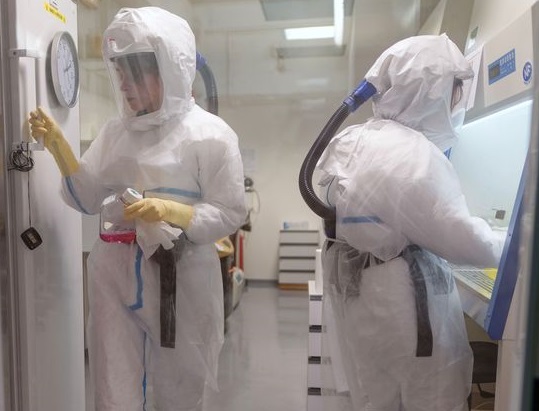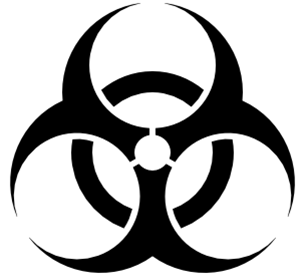Biological agents used for bioterrorism can be delivered or trasmissted in human or animal population through the air, water, food, vector, person-to-person contact
Through air
Dissemination of biological or chemical agents as aerosols in the atmosphere is perhaps the best and most feared method of bioterrorism. This is the most veritable route of disseminating biological and chemical agents in events of chemical or biologic attack. Just few kilograms of a weaponized biological agent (e.g. anthrax spores) are sufficient enough to cause monumental casualties in a given population.
Aerosolization is the primary means of distributing biologic agent, and it is a direct mode of transmission. Most microbes suitable for biological weaponization or chemical attack are usually spread as aerosols via aircraft over a particular area, and they directly affect the respiratory system and incapacitate a large number of victims (Table 1). Biological agents released as aerosols have widespread reach in a given population where they immediately cause disease and death.
All Category “A” biological agents are dispersed as aerosols. Spores of infectious pathogens can easily escape from containment, become aerosolized and cause casualties. Typical example was in the 1970s in a Russian biologic weapon research facility where weaponized anthrax leaked and caused some deaths around the region where the facility was situated. In 2001, letters containing anthrax spores caused infection and death in the U.S. after the spores became aerosolized and subsequently inhaled by unsuspecting individuals.
THROUGH FOOD
Contamination of food with biological agents is another method of distributing biological agents. Food is an indirect route of transmitting biological agents. Consumption of food including meat contaminated with a potent biological agent can sicken and cause death to exposed individuals.
Biological agents in Category “B” are usually transmitted and disseminated through food. In 1984 in Oregon, USA, salads in 11 restaurants was inoculated with S. typhimurium cultures by a suspected cultist group in a bioterrorist attack, and this caused food-borne salmonellosis which sickened many in the region.
Table 1. Estimates of casualties produced by a hypothetical biological attack*
| AGENT | DOWNWIND REACH (KM) | NUMBER KILLED | NUMBER INCAPACITATED |
| Rift valley fever | 1 | 400 | 35,000 |
| Tickborne encephalitis | 1 | 9500 | 35,000 |
| Typhus | 5 | 19,000 | 85,000 |
| Brucellosis | 10 | 500 | 125,000 |
| Q fever | >20 | 150 | 125,000 |
| Tularemia | >20 | 30,000 | 125,000 |
| Anthrax | >20 | 95,000 | 125,000 |
| *Release of 50 kg of agent (aerosolized) by aircraft along a 2-km line upwind of a population center of 500,000. Adapted from: Stefan Riedel (2004). Biological warfare and bioterrorism: a historical overview. BUMC Proceedings, 17:400-406. | |||
THROUGH WATER
Water is another indirect route of disseminating biological and chemical agents to unsuspecting individuals. Polluting wells and water sources of enemies were a common warfare strategy that was used as offensives in battlefields in many European wars, and even in the United States of America till the 19th century.
Early use of biological weapons dates back to about 600 BC, and during the medieval times, cadavers of animals was deposited on water sources of enemies. This strategy caused disease to spread in the enemy’s camp while weakening many, thus incapacitating them for battle. Also, in 1155 in Tortona, Italy, enemy’s wells were poisoned with dead human bodies by Emperor Barbarossa.
THROUGH VECTOR
Zoonotic delivery of biological agents using rodents and insect vectors could be another method of bioterrorism. However, this method is unpredictable and to a large extent inefficient as there are a limited number of biological agents that can be disseminated by this means. Biological agents can also be spread indirectly through insect vectors (e.g. flea-which harbour the bubonic plague bacterium).
Bubonic plague (or Black Death as it is commonly called) is a bacterial disease caused by Y. pestis, and it is one of the most devastating human diseases which killed over 20 million people in Europe in 1346 and beyond. Y. pestis, an LPS endotoxin bacteriumis majorly transmitted or spread in human population through the bite of an infected rodent flea. Humans become infected as the flea takes a blood meal.
Rodents are the animal reservoirs of the disease, and fleas become infected after taking blood meals from these rodents (e.g. squirrels and mice). In 1346, Tartar forces (after experiencing a plague epidemic) hurled plague-infected cadavers of their deceased into Kaffa city (now Feodosia in Ukraine), and this caused plague epidemic in the city, thus giving them a combat advantage over their enemies.
FROM PERSON-TO-PERSON
Person-to-person transmission of biological agents is yet another route via which infectious agents can cause disease and death in a target human population. A handful of smallpox-infected individuals can cause an epidemic in a particular population, and this could result to social disruption, fear and fatigue to available health personnel and resources required to contain the situation.
Person-to-person spread of contagious diseases can occur via direct body contact, aerosols (i.e. in droplet infections), or through animal-human contact. Most biological agents including those in categories A & category B are harbored in domestic and wild animals, and these can go on to cause infection in human population through bites or contact with these animals.
However, most of the tools of mass destruction used by terrorists to case mayhem in a population are often biological and chemical agents (Figure 1); and these agents have a wide reach than any other means of warfare.

References
Aschengrau A and Seage G.R (2013). Essentials of Epidemiology in Public Health. Third edition. Jones and Bartleh Learning,
Aschengrau, A., & G. R. Seage III. (2009). Essentials of Epidemiology in Public Health. Boston: Jones and Bartlett Publishers.
Castillo-Salgado C (2010). Trends and directions of global public health surveillance. Epidemiol Rev, 32:93–109.
Centers for Disease Control and National Institutes of Health (1999). Biosafety in Microbiological and Biomedical Laboratories, 4th edn, Washington DC: CDC.
Guillemin J (2006). Scientists and the history of biological weapons. European Molecular Biology Organization (EMBO) Reports, Vol 7, Special Issue: S45-S49.
Halliday JE, Meredith AL, Knobel DL, Shaw DJ, Bronsvoort BMC, Cleaveland S (2007). A framework for evaluating animals as sentinels for infectious disease surveillance. J R Soc Interface, 4:973–984.
Nelson K.E and Williams C (2013). Infectious Disease Epidemiology: Theory and Practice. Third edition. Jones and Bartleh Learning.
Porta M (2008). A dictionary of epidemiology. 5th edition. New York: Oxford University Press.
Rothman K.J and Greenland S (1998). Modern epidemiology, 2nd edition. Philadelphia: Lippincott-Raven.
Rothman K.J, Greenland S and Lash T.L (2011). Modern Epidemiology. Third edition. Lippincott Williams and Wilkins, Philadelphia, PA, USA.
Discover more from #1 Microbiology Resource Hub
Subscribe to get the latest posts to your email.


